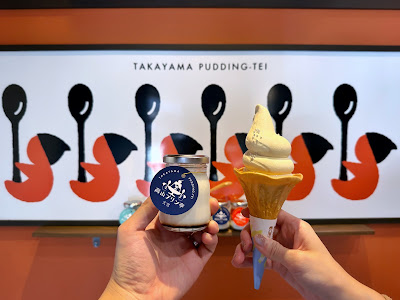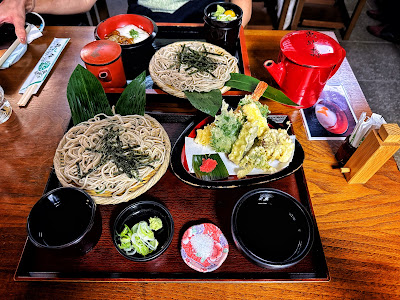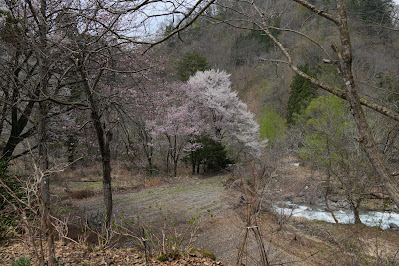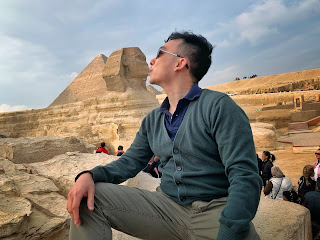The morning train to Takayama yielded the most scenic sights: hilltops cresting along the countryside, with streams of the clearest blue water running parallel to the train. And the best of all, even as most of Japan’s cherry blossom trees had shed, the cooler climate of Takayama meant that there were still a lot in bloom here.
If I could pinpoint my most memorable stop of our trip, it would be Takayama. This small scenic town is away from the hustle and bustle of city life (hello Kyoto and Osaka), and that's the charm. After experiencing the metropolitan life of Osaka and Kyoto, it was immensely pleasurable to once again have the entire sidewalk to yourself.
 |
| The Nakabashi bridge |
As we left Osaka and Kyoto for the mountainous towns, I had expected that the rural cuisine to be less refined. But nothing could be further away from the truth. When you’re in a region of Japan that specialises in producing both high-end beef and excellent sake, every meal is a delight. Osaka, the food capital of Japan, ain’t got nothing on Takayama.
At the old town in Sanmachi district, we had our first bite of the day: top-quality beef sushi. There are many beef specialty sushi stores to choose from, we got ours from Hida Kotte Ushi, which occupies a large historical building and has a beautiful courtyard to enjoy your sushi in. We each had a breathtakingly beautiful beef sushi topped with a quail egg yolk. There's no wastage involved in this restaurant: the sushi were served on large rice crackers instead of plates. The setup isn't meant for customers to eat a whole meal, and it's a revolving door of customers queuing up for a trio of sushi, eating the sushi with both hands, and then departing.
Beware of the red chilli pepper flake cracker. It is intensely spicy, and the burn only builds up further with time. The very first bite blew me away. I nibbled at it about half a cracker before calling it quits.
We sped walked to the nearby always-a-queue Takayama Pudding-Tei for some soft serve ice cream to soothe the chili burn. These come in picturesque cones, and the flavour was surprisingly well-developed with undertones of caramel. We also got some pudding since we were already in the store. It’s delicious - rich, eggy (but not too eggy!) and perfectly perfectly smooth.
Another noteworthy dessert shop is Iwaki, slinging trays of soft jiggly warabi-mochi from its humble storefront. It opens by 9, and is the perfect mid-morning snack. Each portion is actually an entire tray. It looks like quite a lot, and feels hefty too, but ... I forget where I'm headed with this. Anyway, any lingering doubts that two of us could finish an entire tray disappeared midway through, as we demolished it in one sitting. It was that good.
Takayama town contains eight (8!) breweries, and all of them within walking distances of the station/hotel. Isn't it just wonderful? We didn't visit all of them in our 2 nights' stay (would it have been concerning if we had?), but we visited 3 across our 3 days here. I found my favourite sakes at Harada Brewery. Two in particular were intensely fruity and floral, and so very drinkable. Because we were going through a few other towns, including up the Japanese Alps, I weren’t looking to lug any bottles along with me. But I couldn’t help myself after tasting the sake at Harada. I ended up buying a bottle of Sansha Jummai Ginjo Hanakobo Dukuri, a sake with intense lively flavours of pear and stone fruits. I got the larger size of 1.8L, instead of the regular 720ml. (What? The 720ml was 1815 yen and the 1800ml bottle was 3070 yen. It makes so much sense). A regular-sized bottle of their seasonal Sakura also made its way into my shopping bag.
In sake brewing, there's a particular method called Hana Kobo 「花酵母」, which involves cultivating yeast from flowers and using those yeast to make sake. It's as labour-intensive as it sounds, but the yeast gives intense fruity and floral flavours to the sake. It's a style that I've heard of but never had a chance to try before today. The only reason I found out was because the Japanese script for flowers “花” turned out to be the same as its Chinese counterpart, which I saw on the bottles. I asked the clerk who confirmed that they were both Hana Kobo. No wonder both of these sakes tasted like fruit bombs. I uncovered my favourite style of sake.
Another noteworthy dessert shop is Iwaki, slinging trays of soft jiggly warabi-mochi from its humble storefront. It opens by 9, and is the perfect mid-morning snack. Each portion is actually an entire tray. It looks like quite a lot, and feels hefty too, but ... I forget where I'm headed with this. Anyway, any lingering doubts that two of us could finish an entire tray disappeared midway through, as we demolished it in one sitting. It was that good.
Takayama town contains eight (8!) breweries, and all of them within walking distances of the station/hotel. Isn't it just wonderful? We didn't visit all of them in our 2 nights' stay (would it have been concerning if we had?), but we visited 3 across our 3 days here. I found my favourite sakes at Harada Brewery. Two in particular were intensely fruity and floral, and so very drinkable. Because we were going through a few other towns, including up the Japanese Alps, I weren’t looking to lug any bottles along with me. But I couldn’t help myself after tasting the sake at Harada. I ended up buying a bottle of Sansha Jummai Ginjo Hanakobo Dukuri, a sake with intense lively flavours of pear and stone fruits. I got the larger size of 1.8L, instead of the regular 720ml. (What? The 720ml was 1815 yen and the 1800ml bottle was 3070 yen. It makes so much sense). A regular-sized bottle of their seasonal Sakura also made its way into my shopping bag.
In sake brewing, there's a particular method called Hana Kobo 「花酵母」, which involves cultivating yeast from flowers and using those yeast to make sake. It's as labour-intensive as it sounds, but the yeast gives intense fruity and floral flavours to the sake. It's a style that I've heard of but never had a chance to try before today. The only reason I found out was because the Japanese script for flowers “花” turned out to be the same as its Chinese counterpart, which I saw on the bottles. I asked the clerk who confirmed that they were both Hana Kobo. No wonder both of these sakes tasted like fruit bombs. I uncovered my favourite style of sake.
On a side note, I was so excited to buy both that I didn’t scrutinise the labels fully until we left the store, where I took a closer look and developed a sinking feeling that the Japanese characters “生酒”on the seasonal Sakura meant that it was unpasteurised sake (namazake). I had to go back to the store, and unfortunately, I was right. Namazake required refrigeration as much as possible, so not only were we lugging these bottles up the mountain, we also had to ensure the Sakura bottle remained chilled throughout the entire trip. We rushed to get it from one hotel fridge to the next for the next week. But it was well worth it.
The joy of having world-class beef and sake located in one small town was compounded when I found out our hotel room at Residence Hotel Takayama Station came with a kitchen. Say wha-? This sort of hotel room was a first for me. Each ‘room’ of the hotel was a service apartment, with a washing machine/tumbler dryer combination, a kitchen and a small table for meals. A door separates the bedroom from the kitchen, so the cooking aroma doesn’t get into the bedroom, which we deeply appreciated. The kitchen has a large fridge, kitchenware and basic seasoning. There were even brand-new sponges and dishcloths, for crying out loud.
 |
| These cows were so obese, they had started storing fats in their muscles instead of in their subcutaneous layer. |
It was glorious to have a kitchen where we could cook - and eat - all the beef that we wanted. It changed our original plans to go to a Yakiniku restaurant, especially after we walked into a supermarket: every cut is top-grade when you’re in Hida-Takayama. We paired our steak with a sake recommendation from Funasaka Brewery, where after we finished our sake tasting, we spoke with a store assistant and asked her for a sake recommendation to go along with a well-marbled steak. We were directed to 甚五郎爽酒 Jingoro Soshu, a rather clean-tasting sake, with a firm “if you want the Japanese way of pairing sake with food, this is the sake”. Her recommendations left no doubt on which sake I should get. It wasn’t a style that I would have chosen for myself; it was restrained and didn’t leave much of an impression during the sampling. But true to form, its light profile cleared our palates between each bite of the rich steak. Leave it to the professionals to give a solid recommendation.
It didn’t take long to sear a steak and boil a quick soup on the side. We were in and out of the grocery store in 15 minutes, and dinner was ready at the table at the 42th minute of opening the front door. (We know, because the washing machine was still running a load that we started before we went to the brewery. We got a whole routine going on while in Takayama.) As far as having a meal goes, cooking, eating and cleaning up took us about as much time as going to a restaurant. Aside from a slight kerfuckle on what should go inside the soup (I maintain that tomato brings an additional layer of umami alongside tofu, kelp and mushrooms, while the wifey says it’s not traditional), it was immensely enjoyable to cook a quiet dinner together after several hectic days of restaurant and hotel hopping.
Of course, it's silly to cook all the time when travelling - sampling the local cuisine is a big part of my traveling, and we didn't come all the way here to eat our cooking! We also had terrific handmade soba at Ebisu, and ramen at Menya Shirakawa Bettei (麺屋しらかわ 別邸). The regional style of ramen is shoyu-based, a remnant of the Chinese influences on the land.
The old town has two morning markets, Miyagawa and Jinya-mae. They’re located quite close by each other. Perhaps we were a bit early, because most of the stores hadn't fully set up when we were there. We walked both end-to-end within a couple of hours. We bought some souvenirs and had Mitarashi Dango, a regional variant of dango where the glutinous balls are savoury rather than sweet, for breakfast.
 |
| Miyagawa Ryokuchi Park |
A couple of hours from Takayama is the Historic Village of Shirakawa-gō, a small valley town that can be explored in half a day. It is located higher in the mountains, and the air was even cooler. The Sakura trees were in full bloom. It was beautiful.
The land sees a lot of snowfall in winter, and the architecture reflects the challenges they face. The thatched roofs were thickly padded with straw for insulation, and steeply angled to reduce the accumulation of snow on the roofs.
We walked around for a few hours before going to lunch at Hiiragi. As the food came, I was first surprised, then very impressed. I didn’t expect the quality of food to be outstanding and at decent prices. It’s a family-run restaurant, and feels a little like eating at someone’s house. We removed our shoes as we entered and sat on cushions at a low-set table. The beef slices (from Hida naturally) were well-marinated with homemade miso, and grilled at the table over a small fire while insulated by a layer of Hoba (magnolia) leaf. The grilled Ayu fish was larger than expected, and each bite was incredibly tender and sent wisps of steam drifting from the perfectly cooked meat.
After lunch, we continued walking up the road and came to a small bridge across a beautifully raging river. It’s a little away from the beaten path, but well worth the extra 10-odd minutes walk.
It was 2 days well spent in this idyllic town. As a goodbye to Takayama, we grilled a steak for the last meal we had left - breakfast. I also got some milk for tasting (one carton from Hida-Takayama, the other carton from elsewhere as a control). The milk was appropriate for breakfast, the steak less so. It was most definitely too rich for breakfast - I guess I found an upper limit to the amount of top-quality beef one can have.
Recent Japan Travels:
Osaka in Spring 2025: Osaka City (Part 1)
Osaka in Spring 2025: Kyoto and Uji (Part 2)
Osaka in Spring 2025: Hida-Takayama and Shirakawa-Go (Part 3)
Osaka in Spring 2025: Toyama and the Alpine Trail (Part 4)
Osaka in Spring 2025: Matsumoto, Nagano: (Part 5)








































No comments:
Post a Comment